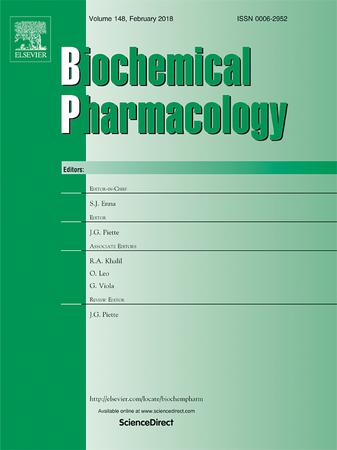尼莫地平、尼群地平和非洛地平对他莫昔芬代谢和分子对接的抑制作用。
IF 5.3
2区 医学
Q1 PHARMACOLOGY & PHARMACY
引用次数: 0
摘要
他莫昔芬是一种用于乳腺癌治疗的选择性雌激素受体调节剂(SERM),需要CYP3A4的代谢激活才能发挥其生物学作用。本研究通过研究钙通道阻滞剂尼莫地平、尼群地平和非洛地平在体内外与他莫西芬的相互作用,评价它们对他莫西芬代谢的影响。采用大鼠肝微粒体(RLM)和人肝微粒体(HLM)体外研究尼莫地平、尼群地平和非洛地平对他莫昔芬代谢的抑制作用。在RLM体外培养系统中筛选了28种心血管药物,包括钙通道阻滞剂。在RLM中,尼莫地平、尼群地平和非洛地平的半数最大抑制浓度(IC50)分别为5.55µM、11.86 µM和7.71µM。在HLM中,尼莫地平、尼群地平和非洛地平的IC50值分别增加到20.38µM、30.06 µM和44.45µM。动力学分析表明,尼莫地平和非洛地平对他莫昔芬的代谢呈竞争性抑制,而尼群地平对RLM的代谢呈非竞争性抑制。非洛地平对HLM表现出非竞争性抑制,尼莫地平和尼群地平表现出竞争性抑制。大鼠药代动力学研究显示,尼莫地平和尼群地平预处理显著增加了他莫昔芬的全身暴露,表现为曲线下面积(AUC)、最大浓度(Cmax)和清除率(CLz/F)的增加。最后,分子对接研究支持了这些发现,显示了CYP3A4活性位点的潜在相互作用。这些结果提示,在临床中,当他莫昔芬与钙通道阻滞剂合用时,需要仔细监测和可能的剂量调整。本文章由计算机程序翻译,如有差异,请以英文原文为准。

Inhibitory effects of nimodipine, nitrendipine and felodipine on tamoxifen metabolism and molecular docking
Tamoxifen, a selective estrogen receptor modulator (SERM) used in breast cancer therapy, requires metabolic activation by CYP3A4 to exert its biological effects. This study evaluated the effects of calcium channel blockers nimodipine, nitrendipine and felodipine on tamoxifen metabolism by studying their interactions with tamoxifen in vitro and in vivo. Rat liver microsomes (RLM) and human liver microsomes (HLM) were used in this study to evaluate the inhibitory potential of nimodipine, nitrendipine and felodipine on tamoxifen metabolism in vitro. A total of 28 cardiovascular drugs, including calcium channel blockers, were screened in an RLM incubation system in vitro. In RLM, nimodipine, nitrendipine and felodipine had half-maximum inhibitory concentration (IC50) values of 5.55 µM, 11.86 µM and 7.71 µM, respectively. In HLM, the IC50 values were increased to 20.38 µM, 30.06 µM, and 44.45 µM for nimodipine, nitrendipine and felodipine, respectively. The kinetic assays indicated that nimodipine and felodipine inhibited the metabolism of tamoxifen in a competitive way, whereas nitrendipine showed non-competitive inhibition in RLM. However, felodipine exhibited non-competitive inhibition, and nimodipine and nitrendipine showed competitive inhibition in HLM. Pharmacokinetic studies in rats revealed that pretreatment with nimodipine and nitrendipine significantly increased the systemic exposure of tamoxifen, as demonstrated by increasing the area under the curve (AUC), the maximum concentration (Cmax) and decreasing the clearance (CLz/F). Finally, molecular docking studies supported these findings, showing potential interactions at the active site of CYP3A4. These results suggested the necessity for careful monitoring and possible dose adjustments of tamoxifen when co-administered with calcium channel blockers in clinic.
求助全文
通过发布文献求助,成功后即可免费获取论文全文。
去求助
来源期刊

Biochemical pharmacology
医学-药学
CiteScore
10.30
自引率
1.70%
发文量
420
审稿时长
17 days
期刊介绍:
Biochemical Pharmacology publishes original research findings, Commentaries and review articles related to the elucidation of cellular and tissue function(s) at the biochemical and molecular levels, the modification of cellular phenotype(s) by genetic, transcriptional/translational or drug/compound-induced modifications, as well as the pharmacodynamics and pharmacokinetics of xenobiotics and drugs, the latter including both small molecules and biologics.
The journal''s target audience includes scientists engaged in the identification and study of the mechanisms of action of xenobiotics, biologics and drugs and in the drug discovery and development process.
All areas of cellular biology and cellular, tissue/organ and whole animal pharmacology fall within the scope of the journal. Drug classes covered include anti-infectives, anti-inflammatory agents, chemotherapeutics, cardiovascular, endocrinological, immunological, metabolic, neurological and psychiatric drugs, as well as research on drug metabolism and kinetics. While medicinal chemistry is a topic of complimentary interest, manuscripts in this area must contain sufficient biological data to characterize pharmacologically the compounds reported. Submissions describing work focused predominately on chemical synthesis and molecular modeling will not be considered for review.
While particular emphasis is placed on reporting the results of molecular and biochemical studies, research involving the use of tissue and animal models of human pathophysiology and toxicology is of interest to the extent that it helps define drug mechanisms of action, safety and efficacy.
 求助内容:
求助内容: 应助结果提醒方式:
应助结果提醒方式:


